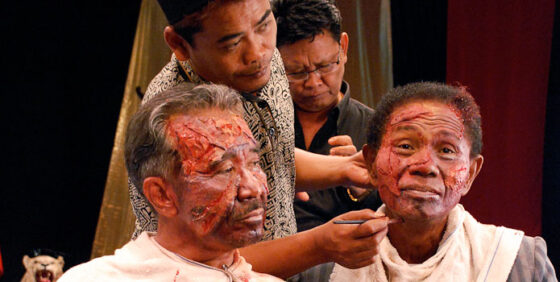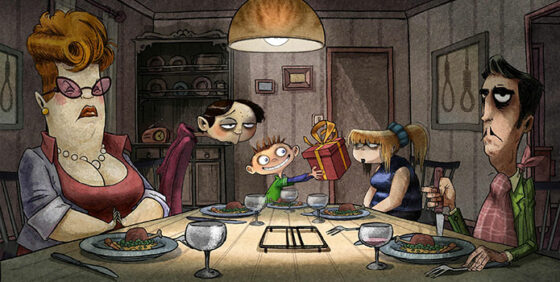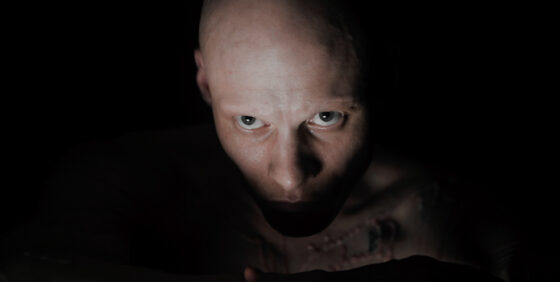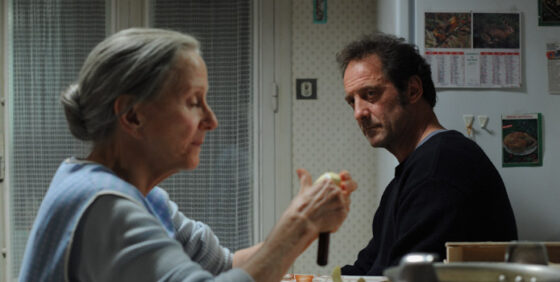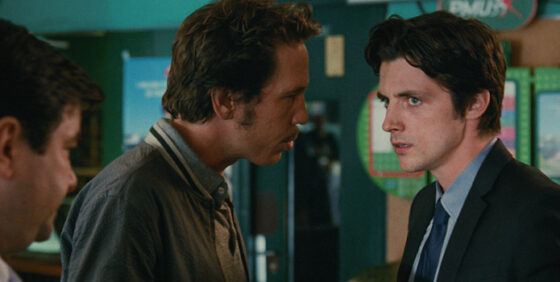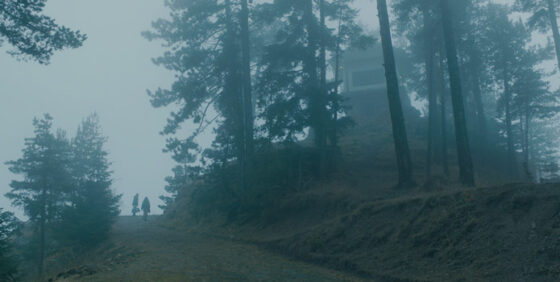TIFF Day 4: The Act of Killing | Dans la maison | La magasin des suicides | On the Road | Painless | Quelques heures de printemps | The Sapphires | Thermae Romae | Trois mondes | Watchtower
The Act of Killing (Joshua Oppenheimer, Christine Cynn, Anonymous, Denmark/Norway/UK)—TIFF Docs
By Adam Nayman
Like most other documentaries about certifiably insane people, The Act of Killing raises questions about the exploitation of its subjects. A related question: is it possible to exploit men who freely—and in some cases gleefully—admit to the torture, rape and murder of untold scores of their countrymen? And also: Why would these people not only want to speak on the record about their guilt but participate in a film that restages their crimes with them in the starring roles—bascially Sweded versions of historical atrocities?
That Werner Herzog and Errol Morris became executive producers after the fact gives some hints about how to try to process The Act of Killing. Morris surely responded to the way that director Joshua Oppenhimer reveals the unfathomable strangeness of wizened former Indonesian paramilitaries simply by putting them in front of a camera, while Herzog must have appreciated the Little Dieter-ish ways in which the re-enactments—several of which are contrived to resemble the Hollywood genre films that the genocidaires embraced in their youth—at once caricature and subsume the reality of their real-world referents (the mid-’60s purges of communists and intellectuals that claimed one million lives).
It is arguable that neither of these venerated directors has ever made a film this unnerving, and while this definitely has something to do with Oppenheimer’s patience, guile, opportunism and curiosity (all equally valid documentary tools), it seems more a simple fact of his subjects’ unique pathologies. Celebrated at home on talk shows and on the streets as brutal conquerors, they’ve never sought outlets for their guilt, and the thriftily produced films-within-the-film seem to filter a wretched spectrum of impulses—pride, wrath, lust… basically all of the deadly sins—through inchoate fear, regret and self-loathing. How does one respond to a scene where a man who strangled others to death with wire replays the scenario from the victim’s chair, done in the style of the gangster movies from which he borrowed both his youthful swagger and his preference for razor wire? And then when he watches the spectacle on television with his grandchildren, cueing them to see how sad it is? It’s hopefully not glib to say that The Act of Killing earns its literally vomitous endnote.
Dans la maison (François Ozon, France)—Special Presentation
By John Semley
To its credit, the protestations against the middle-class that crop up with wink-nudge frequency in François Ozon’s latest seem entirely disingenuous. Adapted from Juan Mayorga’s play The Boy in the Last Row, Dans la maison casts Ernst Umhauer as Claude, a sixteen-year-old creative writing prodigy obsessed with his classmate’s (Bastien Ughetto) seemingly “perfect” family and Frabrice Luchini as Mr. Germaine, the (too) deeply invested literature teacher pushing him to explore his perverse desires so that he may get off by proxy in grading his assignments, co-conspirators in gumshoe perversion.
Germaine pushes his student deeper into his friend’s family life (where he’s inserted himself under the auspices of being a math tutor), egging him into exploring the listless lady of the house’s (Emmanuelle Seigner) “middle-class curves,” all the while chiding his prose, irony and unbelievable plot twists. Yet Ozon (knowingly, it seems) keeps his narrative pitching along these same middle-class curves, expressing the same fissure between bourgeois taste and bourgeois talent that defines Germaine’s own failed writing career. (He also teaches at a school named after Flaubert, broadly gesturing to the film’s own incurably bored Bovary lite.)
In scene that defines the film’s modest ambitions of middle-brow self-awareness, Germaine and his wife (Kristin Scott Thomas) line up at the cinema to see Woody Allen’s Match Point (2005). As their back-and-forth bickering is shushed by the theatre’s more devoted patrons, Ozon’s camera tilts up to the stream of light cast by the projector, equating Allen’s pleasant-enough date-night popcorn romance with his own film. Well before Ozon has Germaine clubbed unconscious with a hardbound copy of Journey to the End of Night, Dans la maison has firmly entrenched itself in the strain of populist satire it bogusly condemns. It’s no Flaubert, but then it only aspires to Match Point.
La magasin des suicides (Patrice Leconte, France/Belgium/Canada)—Special Presentation
By John Semley
An animated film about a mom-and-pop shop specializing in suicide paraphernalia (poisons, razor blades, traditional Japanese samurai swords), La magasin des suicides opens with a sullen-eyed pigeon (perhaps the same pest preoccupying Jean-Louis Trintignant in Amour?) circling listlessly around a dreary city, watching as a man attempts to plank in front of an oncoming bus, only to be yanked back by a passerby. Lectured on the nuisance of suicide fines resulting from offing yourself in public (a cheeky, passably ironic joke that defines the bulk of the film’s humour), the film’s first would-be corpse is taken to the eponymous boutique, encouraged to pursue his demise at his leisure. The shop is owned and operated by the morose Tuvaches, who break out into song-and-dance only to settle back into their listless routines. Their contempt for each other, and for having to shuffle about this mortal coil at all (their duty to their customers is the only thing keeping them alive), is topsy-turveyed when the newest Tuvache, Alan, comes bouncing into the world. The irrepressibly cheerful Alan plots to turn his family’s frowns upside down, while the family’s patriarch plots to kill his young son (albeit slowly, with cigarettes).
Brief and light even in its ostensible heaviness, La magasin des suicides succeeds by sticking to its comically cadaverous tone, right to the last gratis suicide and the revival of the film’s various corpses as singing ghosts. The assault of gallows humour suggests Barry Sonnenfeld’s madcap macabre Addams Family Values (1993) or what Tim Burton might get up to where he not playing with Disney money. Leconte flirts with the idea of connecting the uptick in sales at the Suicide Shop to the current economic downturn, but the film’s dreary-drole tone and stylized grotesquerie connects it to a longer tradition of European malaise. Things are further enlivened by the light-touch use of 3-D, which makes the whole thing resemble an ornate diorama.
La magasin des suicides can’t really sell its various musical interludes; maybe things like that are invariably lost in translation, the disjoint between lyrics and subtitles spoiling the rhythm, metre, etc. But while even Sylvain Chomet’s largely silent Les Triplettes de Belleville (2003) managed a few hum-worthy numbers, La magasin des suicides offers no melodies fit for whistling past the grave.
On the Road (Walter Salles, France/Brazil)—Special Presentation
By Kiva Reardon
We begin in a parking lot, as Dean Moriaty (Garrett Hedlund) slams brakes and screeches wheels in a ballet of fancy vehicular tricks. Distilling Jack Kerouac’s novel to its most basic theme, director Walter Salles hammers home the point in the first two minutes: Dean can’t be confined. Then the film goes on for another two hours. Pulling extensively from Kerouac’s text, Sal Paradise (Sam Riley) narrates his “life on the road” with Dean: threesomes with Marylou (Kristen Stewart), stopovers in New Orleans with Old Bull Lee, a.k.a. William S. Burroughs (Viggo Mortensen), domestic doldrums with Camille (Kirsten Dunst), hallucinogenic trips in Mexico. Alternating between the Sundance aesthetic of washed-out hard light (the city, hangovers, any scene where there’s a child or responsibility) and super-saturated warm tones (parties, drinking, any scene featuring breasts), Salles’ adaptation is remarkably monotonous. Though it might have been Salles’ aim to capture the juvenile dreams of his characters, the celebratory tone of the ending (taken from the book) of Paradise pecking away at his typewriter throughout the night places this firmly in that insufferable realm of venerating the tortured male writer. It’s enough to give you motion sickness on this long, dull road trip.
Painless (Juan Carlos Medina, Spain/Portugal/France)—Vanguard
By Violeta Kovacsics
M. Night Shyamalan’s Unbreakable (2000) starts with the long take of a newborn child, whose bones were broken while exiting the womb. The scene is already telling us the resolution of the plot, the last surprise: the story of a man that becomes a superhero is also the story of a child that became a villain. Painless opens with a girl burning her arm without feeling any pain: it doesn’t need much time to set the basis of its story, the tale of a group of children that, during the Spanish Civil War, could not feel pain. As we already know the heart of the story, is there any need to add a contemporary plot about a man who is digging into his family’s past? Painless lies somewhere between Agustí Villaronga’s Black Bread (depicting how a child becomes a monster) and Guillermo del Toro’s The Devil’s Backbone (moving between history and fantasy). The universe of Painless is its strongest charm: the way it creates a monster, the old hospital as a unique space for the flashback plot, the mix of history and magic elements. The problem is the script. We have two stories that should go together—the painless children during the 1930s, and a surgeon who needs to find his biological parents in order to have bone marrow transplant—but they move separately, as if they didn’t need each other to exist. Where Unbreakable eventually circles back with purpose to its opening shot, Painless never quite comes together.
Quelques heures de printemps (Stéphane Brizé, France)—Special Presentation
By Olivier Père
Despite its subject matter, Quelques heures de printemps is not so much a film with a message about euthanasia, but primarily an exploration of a mother and son relationship and the drama of two people who are unable to communicate, inseparable yet antagonistic. Quelques heures de printemps is about a love that is impossible to express and admit to between a mother and her son, who has reached adulthood without resolving his issues with her, and who is incapable of building his own life and finding happiness. Vincent Lindon is pitch-perfect as the silent and withdrawn man, while Hélène Vincent is absolutely magnificent in the role of the mother.
The words “delicacy” and “emotion” are those that come to mind when watching Stéphane Brizé’s film. Quelques heures de printemps indisputably demonstrates that Brizé has achieved a precocious form of success in his filmmaking ambitions, both in terms of the remarkable script and the mise en scène. Beneath the deliberate classicism, the film reveals the wonders of mise en scène: we are no longer solely in an understated register, but one that is pared down to the bare bones, with relentless, rigorous frontal shots that move one to tears because they confine themselves to recording what simply is, with a truth that transcends naturalism. The long takes of the final and most important sequence are so admirable they stand comparison with Ozu, Dreyer, and Pialat. Brizé has made a film that avoids stylistic bravura but has a totally commanding power.
The Sapphires (Wayne Blair, Australia)—Special Presentation
By Richard Porton
Derivative and laughably inept, Chris O’Dowd’s The Sapphires has to be seen to be disbelieved. Snapped up by the Weinstein Company before Cannes, presumably because they viewed it as an Australian variant of Dreamgirls (2006) or Sparkle, the film is both badly made and manages to recycle every girl-group cliché under the sun. Bound up with the travails of an aboriginal quartet as they overcome racist hurdles in Australia and eventually tour wartime Vietnam as triumphant songbirds during the ’60s, this mini-epic about Motown imitators who are fortuitously named “The Sapphires” becomes bogged down in squabbles between the members—particularly sisters Gail (Deborah Mailman) and Cynthia (Miranda Tapsell)—and the supposedly witty banter of Dave (played by O’Dowd himself), their hyperkinetic manager with a weakness for lame jokes. Perhaps the most offensive aspect of this otherwise forgettable enterprise is its tendency to make the horrors of the war in Vietnam a mere backdrop for The Sapphires’ rise to fame and fortune. (The complications of bad blood between the sisters and their “ half-caste cousin” Julie are dispatched in a perfunctory fashion.) An evening at home listening to The Supremes would be a much more pleasurable option than enduring this misfire.
Thermae Romae (Takeuchi Hideki, Japan)—Gala Presentation
By Mark Peranson
(Watched on Air Canada flight 873.)
Puh-lease.
Our insanely popular manga adaptation begins in the 2nd century A.D., where the thermae, or Roman baths, have turned from oases of reflection into something out of Spring Breakers. (They even sell pastries.) Novel ideas are needed in this faltering economy, or the Roman Empire will fall. Enter one Lucius Modestus (Hiroshi Abe), public baths architect, and while plunged beneath to come up with something to save the empire, faster that you can say Theodore Logan, the idea-free architect finds himself transported to present-day Japan, a world of wonders populated by a “Flat-Faced Clan” that has invented fruity milk, valuable papyrus that hangs on the bathroom wall, and bidets. (Just about every example of modern progress that Lucius sees, such as the toilet seat, he imagines is a result of slave labour; this is a joke that is funny exactly no times.) This time-travel pattern goes on for what seems like forever, the bait-and-switch coming when a Latin-speaking manga artist-slash-bathroom supply saleswoman obsessed with this strange Lucius herself ends up in ancient Rome, and puts her knowledge of ancient history to use to ensure that the historical reputation of the Emperor remains intact, or something.
About the only reason to see Thermae Romae is to hear Japanese men and women pronounce “Lucius.” Even watching it on an airplane—which I did en route to the Toronto International Film Festival—I felt so uninvolved with this garbage that I was impelled to reply to old email, and I wasn’t even online. And I always like watching movies on airplanes. Might I propose a new section for TIFF focusing on box-office hits in their native lands—say, “Blockbusters”—so that unsuspecting viewers know what they are spending their money on, and can check their brains at the door. But I guess they already have Galas.
Trois mondes (Catherine Corsini, France)—Contemporary World Cinema
By Blake Williams
Three years after Leaving, Catherine Corsini’s hit melodrama from the 2009 festival circuit, it appears as though she has yet to return. Already dissolving from memory as the credits roll, Trois mondes’ worst offence is that its basic premise is too much in conversation with Lucrecia Martel’s masterful and elusive The Headless Woman. Both films are centred upon a hit-and-run accident, after which the driver loses grip on reality and unveils a suppressed classism and nationalism. In Corsini’s film, however, it’s never a question whether the roadkill is man or canine; Alan, the driver and protagonist, is explicitly shown hitting a man, who we later learn is an immigrant construction worker.
Trois mondes is a film where all of the subtext resides squarely on its surface. Early scenes tell us that Alan is the son of a maid; she cleans the house of a car salesman, Testard, who completes the circle by being Alan’s employer (not to be outdone, the woman Alan plans to marry is Testard’s daughter). Once the immigrant comes into the picture, we have before us every rung of the socio-economic ladder, wobbling and swaying in precise motions. Flat and broad as its attempt at humanism is, it’s Trois mondes’ carefully convoluted and contrived narrative that’s most off-putting; Alan behaves irrationally for the sake of setting up the next twist, like he knows this can’t go anywhere good if he does what he should. So when the resolution finally comes, it isn’t nearly as cathartic or satisfying as Corsini hopes because she ensures that Alan—and we—are never unaware of the stakes he’s up against and how he came to be up against them. It’s a dependence on tangibility that Martel wisely resisted.
Watchtower (Pelin Esmer, Turkey/Germany/France)—Contemporary World Cinema
By Adam Nayman
Two solitudes: a man lives alone in an isolated perch, while a woman is driven around in endless circles on a rural bus route. Nihat (Olgun Simsek) is a fire warden, Seher (Nilay Erdonmez) is a coach hostess, and it is of course only a matter of time before the writer-director who placed them in their parallel prisons finds a way to bring them together. The meeting, when it comes, is a great relief—not because it suggests two parched souls coupling, but because it means that Watchtower is approximately halfway through its running time.
This is not to say that Pelin Esmer’s film is bad, exactly. Working in a patient, methodical style reminiscent of not only certain other Turkish auteurs but the bulk of so much contemporary “festival cinema,” Esmer establishes an impressive sense of place—a wooded no-man’s-land filled with portent—and she brings off her calculatedly visceral centrepiece sequence, which adds a third important character to the mix, with real aplomb. What she doesn’t do is imbue her allegory about the forcibly furtive nature of Turkish womanhood with any real urgency. Nor does she get an evocatively blank performance from Simsek, whose immobility contains not multitudes but rather the singularity of an actor with nothing to play. Erdonmez has the opposite problem: her performance has been conceived as a steady escalation that eventually goes through the roof in an aria of rage and accusation that, while impressively pitched and sustained, isn’t enough to rouse the movie from its own carefully managed doldrums.
cscope2- « Previous
- 1
- 2

